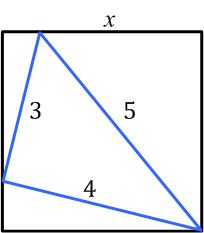
I was really trying to avoid getting pulled into more addictive geometric challenges from Catriona Shearer (since they can consume your every waking moment), but a recent post by Ben Orlin, “The Tilted Twin (and other delights),” undermined my intent. As Orlin put it, “This is a countdown of her three favorite puzzles from October 2019” and they are vintage Shearer. You should check out Olin’s website since there are “Mild hints in the text; full spoilers in the comments.” He also has some interesting links to other people’s efforts. (Olin did leave out a crucial part of #1, however, which caused me to think the problem under-determined. Checking Catriona Shearer’s Twitter I found the correct statement, which I have used here.)
I have to admit, I personally found the difficulty of these puzzles a bit more challenging than before (unless I am getting rusty) and the difficulty in the order Olin listed. Again, the solutions (I found) are simple but mostly tricky to discover. I solved the problems before looking at Olin’s or others’ solutions.
See the Geometric Puzzle Mayhem.

 This is another problem from the Math Challenges section of the 2000 Pi in the Sky Canadian math magazine for high school students.
This is another problem from the Math Challenges section of the 2000 Pi in the Sky Canadian math magazine for high school students. Presh Talwalkar had another interesting
Presh Talwalkar had another interesting  This problem from the 1987 Discover magazine’s Brain Bogglers by Michael Stueben apparently traces back to 1770, though the exact reference is not given.
This problem from the 1987 Discover magazine’s Brain Bogglers by Michael Stueben apparently traces back to 1770, though the exact reference is not given. I found this problem from the Math Challenges section of the 2002 Pi in the Sky Canadian math magazine for high school students to be truly astonishing.
I found this problem from the Math Challenges section of the 2002 Pi in the Sky Canadian math magazine for high school students to be truly astonishing. Here is yet another surprising result from Colin Hughes at Maths Challenge.
Here is yet another surprising result from Colin Hughes at Maths Challenge. This is another train puzzle by H. E. Dudeney. This one has some hairy arithmetic.
This is another train puzzle by H. E. Dudeney. This one has some hairy arithmetic. It is always fascinating to look at problems from the past. This one, given by Thomas Whiting himself, is over 200 years old from Whiting’s 1798 Mathematical, Geometrical, and Philosophical Delights:
It is always fascinating to look at problems from the past. This one, given by Thomas Whiting himself, is over 200 years old from Whiting’s 1798 Mathematical, Geometrical, and Philosophical Delights: This is another intriguing problem from Presh Talwalkar.
This is another intriguing problem from Presh Talwalkar.